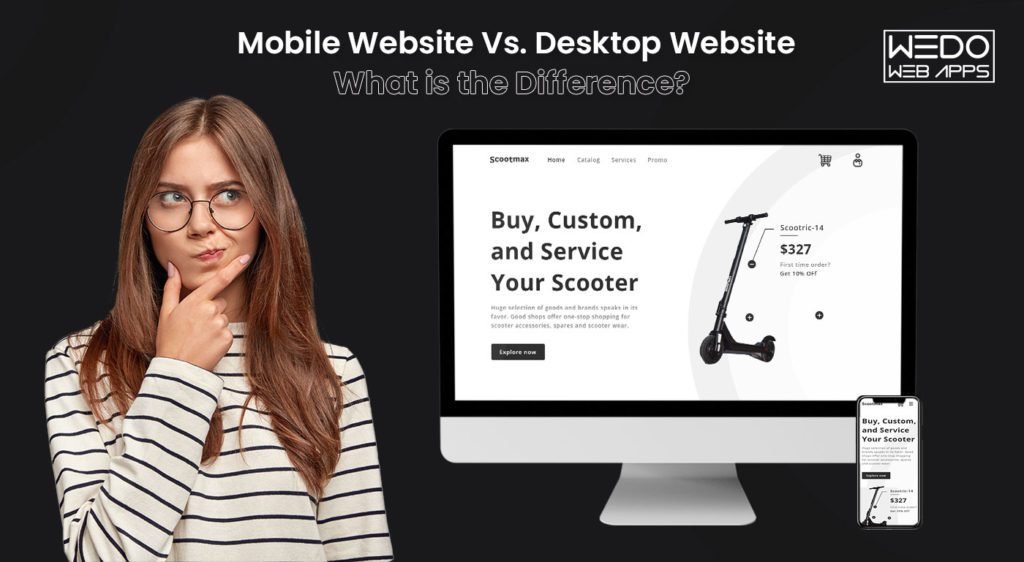19 Nov, 2022 | Responsive Web Design Services
Mobile Website Vs. Desktop Website - What is the Difference?

What is a Mobile Website?
In contrast to the very small and tiny texts and heavy graphics and navigation experience of a desktop site on your smartphones and tablets, mobile sites are specially designed and scaled to function well on smartphone screens. Because smartphone users want essential decision-making information when they are looking for a service you offer, a mobile website is what can help you attract that customer. Using fonts and graphics that are easier and larger to navigate and read in smaller screen sizes can help you entice your website visitors.What a Mobile Website Isn't?
Being a responsive web design company, the widespread misconception we hear about mobile websites is, "Mobile websites are just the smaller version of the regular desktop websites." Now, take your mobile phones out and try to browse any website, even maybe your own. If you see a tiny version of your traditional website, if it requires you to use your fingers to expand and see the content on your website, you are merely viewing the desktop version of your website on your smartphone. This is absolutely not a mobile website. In the following section, let's talk about the critical differences between a traditional or desktop website and a mobile website.Key Design Differences between Mobile and Desktop Websites
Let's start with the fact that mobile browsing is absolutely different from desktop websites. Further in this post, we will see how user interactions on websites differ from interactions on mobile sites. These differences will be beneficial for you to design a better-optimized website.- Tappable vs. Clickable Interactions
- Dropdown Menus
- Navigation
- Content Prioritization
- Situation-based Design
- Integration with Phone Functions
How is Mobile Site Important for Your Business?
You might have developed the world's best marketing strategy, the most enticing website design, and the most robust audience that supports your brand but still not be able to make the desired sales from your business. That is because you don't have a mobile website that is currently the most critical requirement of your business. As we all know, most of the website traffic these days comes from mobile devices and not desktops. Therefore it is vital to develop a mobile website to increase conversions. Below are the reasons why your business needs a mobile website:- Increased Mobile Phone Users
- Enhanced Customer Experience
- Faster Download and Website Load Speed
- Improved Search Engine Ranking
- Business Becoming More Competitive
Mobile Website - A Necessity or Not?
There still exist a lot of computers, laptops, and therefore, the need for a classic website design is not going anywhere soon - and even after so much hype of mobile websites, desktop websites are never going to vanish off completely. However, mobile devices are a preferred medium for website browsers, and therefore your mobile websites need to be ready for action. Here, at WeDoWebApps LLC, we know exactly what a responsive website design is. This means we are experts at developing websites that can function well on any device it is being operated on. We stand ready to offer you the best responsive web design services to help you gain immense popularity and become the best in the industry.Frequently Asked Questions
A mobile website is a website designed specifically for smaller screens, such as smartphones and tablets. Mobile websites are optimized for touch inputs and have simplified designs to ensure that they are easy to navigate and load quickly on mobile devices.
A desktop website is a website designed for larger screens, such as desktop computers and laptops. Desktop websites have more complex designs and navigation menus to display more extensive content and provide a more in-depth user experience.
The most significant difference between mobile and desktop websites is the screen size and resolution. Mobile websites are designed to display content on smaller screens, while desktop websites are designed for larger screens. Additionally, mobile websites have simplified navigation menus, shorter load times, and touchscreen compatibility.
Having a mobile-friendly website is essential because mobile devices are now the primary means of accessing the internet. If your website is not optimized for mobile devices, it can result in a poor user experience, high bounce rates, and reduced conversions. A mobile-friendly website ensures that your website is accessible to users across all devices, providing a seamless user experience that can increase engagement and conversions.
Responsive web design is a design approach that ensures that a website can adapt to different screen sizes and devices. A responsive website design adjusts the layout, navigation, and content of a website to ensure that it is easily readable and navigable on any device.
While you can use the same content on your mobile and desktop website, it's essential to optimize the content for each device. Mobile users tend to have shorter attention spans, so it's crucial to provide more concise, easily digestible content on mobile websites. Additionally, mobile websites may require shorter load times and simplified navigation menus to ensure a seamless user experience.

